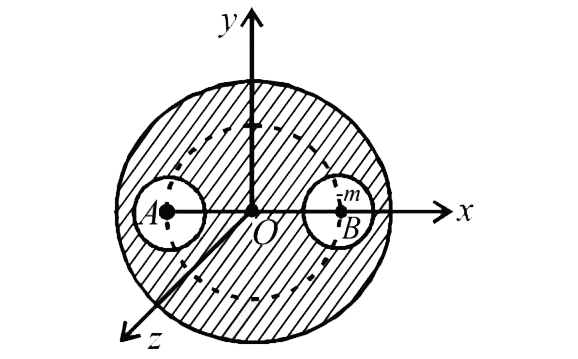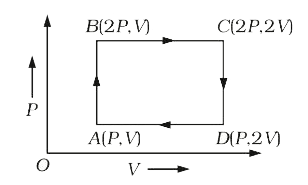Take the mean distance of the moon and the sun from the earth to be0.4×106km and 150×106km respectively. Their masses are 8×1022kg and 2×1030kg respectively. The radius of the earth of is 6400km. Let ΔF1be the difference in the forces exerted by the moon at the nearest and farthest points on the earth and ΔF2 be the difference in the force exerted b the sun at the nearest and farthest points on the earth. Then, the number closest to ΔF1ΔF2 is :
2
10−2
0.6
6
The correct Answer is:A
dme=0.4×106 km, dse=150×106km , mm=8×1022kg ms=2×1030 kg Re=6.4×106 m
ΔF1=GMmm[1(dme−Re)2−1(dme+Re)2]=GMmmdme4×(4dmeRe)
ΔF2=GMmsdse4×(4dseRe).ΔF1ΔF2=mmd3semsd3me=2
Topper's Solved these Questions
- GRAVITATIONBook:VMC MODULES ENGLISHChapter:GRAVITATIONExercise:JEE Advance (Archive) SINGLE OPTION CORRECT
Explore 14 Videos
- GRAVITATIONBook:VMC MODULES ENGLISHChapter:GRAVITATIONExercise:JEE Advance (Archive) MULTIPLE OPTIONS CORRECT TYPE
Explore 5 Videos
- GRAVITATIONBook:VMC MODULES ENGLISHChapter:GRAVITATIONExercise:Level-2
Explore 30 Videos
- GASEOUS STATE & THERMODYNAMICSBook:VMC MODULES ENGLISHChapter:GASEOUS STATE & THERMODYNAMICSExercise:JEE ADVANCED (ARCHIVE )
Explore 109 Videos
- INTRODUCTION TO VECTORS & FORCES Book:VMC MODULES ENGLISHChapter:INTRODUCTION TO VECTORS & FORCES Exercise:JEE Advanced ( ARCHIVE LEVEL-2)
Explore 12 Videos
Similar Questions
If the radius of the earth were to shrink by one per cent, its mass remaining the same, the accleration due to gravity on the earth's surface would
View SolutionA solid sphere of uniform density and radius 4 units is located with its centre at the origin O of coordinates. Two sphere of equal radii 1 unit, with their centres at A(-2,0 ,0) and B(2,0,0) respectively, are taken out of the solid leaving behind spherical cavities as shown if fig Then:

View SolutionFour particles having masses, m, 2m, 3m, and 4m are placed at the four corners of a square of edge a. Find the gravitational force acting on a particle of mass m placed at the centre.
View SolutionAn ideal gas is taken around the cycle ABCDA as shown in the P-V diagram. What is the work done during the cycle?

View SolutionA block of mass 2 kg rests on a rough inclined plane making an angle of 30∘ with the horizontal. The coefficient of static friction between the block and the plane is 0.7. The frictional force on the block is
View SolutionThe distance between earth and moon is 3.8×108m. Determine the gravitational potential energy of earth-moon system. Given, mass of the earth =6×1024kg, mass of moon =7.4×1022kg and G=6.67×10−11Nm2kg−2
View SolutionThe mass of the earth is 6 × 10^(24) kg and that of the moon is 7.4 xx 10^(22) kg. If the distance between the earth and the moon is 3.84xx10^(5) km, calculate the force exerted by the earth on the moon. (Take G = 6.7 xx 10^(–11) N m^(2) kg^(-2) )
View SolutionFind the distance of a point from the earth's centre where the resultant gravitational field due to the earth and the moon is zero The mass of the earth is 6.0×1024kg and that of the moon is 7.4×1022kg The distance between the earth and the moon is 4.0×105km .
View SolutionWhat is the force acting on a body of mass 10,000 kg on earth, due to the gravity of the sun? Also find the force on the body due to the gravity of the moon. Which exerts more force, the sun or the moon? Mass of the sun = 2 xx 10^(30) kg, Mass of the moon = 7.3 xx 10^(22) kg, Distance between the sun and the Earth = 1.5 xx 10^(11) m Distance between the moon and the Earth = 3.84 xx 10^(8) m Radius of the Earth = 6.4 xx 10^(6) m
View SolutionTake the mean distance of the moon and the sun from the earth to be 0.4 xx 10^(6) km and 150 xx 10^(6) km respectively. Their masses are 8 xx 10^(22) kg and 2 xx 10^(30) kg respectively. The radius of the earth of is 6400 km . Let DeltaF_(1) be the difference in the forces exerted by the moon at the nearest and farthest points on the earth and DeltaF_(2) be the difference in the force exerted b the sun at the nearest and farthest points on the earth. Then, the number closest to (DeltaF_(1))/(DeltaF_(2)) is :
View SolutionThe masses of the earth and moon are 6×1024kgand7.4×1022 kg , respectively , The distance between them is 3.84×105 km. Calculate the gravitational force of attraction between the two. Use G=6.7×10−11N.m2kg−2
View Solutionपृथ्वी के केंद्र से उस बिंदु की दूरी ज्ञात करों जहाँ पृथ्वी एवं चंद्रमा के कारण परिणामी गुरूत्वीय क्षेत्र का मान शून्य है। पृथ्वी का द्रव्यमान 6.0×1024kg और चंद्रमा का द्रव्यमान 7.4×1022kg ले । पृथ्वी एवं चंद्रमा के बीच की दूरी 4.0×105km ले।
View SolutionThe mass of the earth is 6×1024 kg and that of the moon is7.4×1022 kg. If the distance between the earth and the moon is 3.84×105 km, calculate the force exerted by the earth on the moon. (Take G =6.7×10–11Nm2kg−2)
View SolutionTake the mean distance of the moon and the sun from the earth to be 0.4 xx 10^(6) km and 150 xx 10^(6) km respectively. Their masses are 8 xx 10^(22) kg and 2 xx 10^(30) kg respectively. The radius of the earth of is 6400 km . Let DeltaF_(1) be the difference in the forces exerted by the moon at the nearest and farthest points on the earth and DeltaF_(2) be the difference in the force exerted b the sun at the nearest and farthest points on the earth. Then, the number closest to (DeltaF_(1))/(DeltaF_(2)) is :
View SolutionFind the ratio of escape velocities from the earth and the moon. (Mass of the earth = 6.0×1024 kg, Radius of the earth = 6400km, Mass of the moon = 7.4×1022 kg Radius of the moon 1740 km.)
View SolutionFind the ratio of escape velocities from the earth and the moon. (Mass of the earth = 6.0×1024kg, Radius of the earth = 6400 km, Mass of the moon =7.4×1022kg Radius of the moon = 1740 km.)
View Solution
